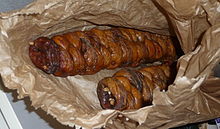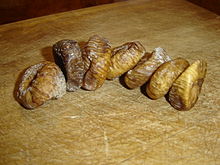Ficus carica is an Asian species of flowering plant in the mulberry family, known as the common fig (or just the fig). It is the source of the fruit also called the fig and as such is an important crop in those areas where it is grown commercially. Native to the Middle East and western Asia, it has been sought out and cultivated since ancient times and is now widely grown throughout the world, both for its fruit and as an ornamental plant.[3][4] The species has become naturalized in scattered locations in Asia and North America.
Food that starts with J
Etymology
The word fig, first recorded in English in the 13th century, derives from (Old) French figue, itself from Occitan (Provençal) figa, from Romance *fica, from Classical Latin ficus (fig or fig-tree).[7] Italian has fico, directly derived from Latin ficus. The name of the caprifig, Ficus caprificus Risso, is derived both from Latin capro (billygoat) and English fig.[8]
Biology
Ficus carica is a gynodioecious, i. e., functionally dioecious,[9] deciduous tree or large shrub that grows up to 7–10 metres (23–33 ft) tall, with smooth white bark. Its fragrant foliage is 12–25 centimetres (4.7–9.8 in) long and 10–18 centimetres (3.9–7.1 in) wide, and deeply lobed with 3 or 5 lobes. The complex inflorescence consists of a hollow fleshy structure denominated the "syconium", which is lined with numerous unisexual flowers. The flowers are not visible outside the syconium because they bloom inside the infructescence. Although commonly denominated a "fruit", the fig is in truth the infructescence or scion of the tree, known as a "false fruit" or "multiple fruit", which bears the flowers and seeds. It is a hollow-ended stem that contains many flowers. The small orifice, denominated the "ostiole", that is visible on the middle of the fruit is a narrow passage, which allows the specialized fig wasp, Blastophaga psenes to enter the fruit and pollinate the flowers, after which the fruit grows seeds. See Ficus: Fig fruit and reproduction system.
The edible fruit consists of the mature syconium that contains numerous one-seeded fruits, denominated "druplets".[9] The fruit is 3–5 centimetres (1.2–2.0 in) long, with a green skin that sometimes ripens toward purple or brown. Ficus carica has milky sap, thus rendering it a laticifer. The sap of the green parts is an irritant to human skin.[10]
From ancient times[edit]
The edible fig is one of the first plants that was cultivated by humans. Nine subfossil figs of a parthenocarpic (and therefore sterile) type dating to about 9400–9200 BCE were found in the early Neolithic village Gilgal I (in the Jordan Valley, 13 km north of Jericho). The find precedes the domestication of wheat, barley, and legumes, and may thus be the first known instance of agriculture. It is proposed that this sterile but desirable type was planted and cultivated intentionally, one thousand years before the next crops were domesticated (wheat and rye).[14]
Figs were widespread in ancient Greece, and their cultivation was described by both Aristotle and Theophrastus. Aristotle noted that as in animal sexes, figs have individuals of two kinds, one (the cultivated fig) that bears fruit, and one (the wild caprifig) that assists the other to bear fruit. Further, Aristotle recorded that the fruits of the wild fig contain psenes (fig wasps); these begin life as larvae, and the adult psen splits its "skin" (pupa) and flies out of the fig to find and enter a cultivated fig, saving it from dropping. Theophrastus observed that just as date palms have male and female flowers, and that farmers (from the East) help by scattering "dust" from the male on to the female, and as a male fish releases his milt over the female's eggs, so Greek farmers tie wild figs to cultivated trees. They do not say directly that figs reproduce sexually, however.[15]
Figs were also a common food source for the Romans. Cato the Elder, in his c. 160 BCE De Agri Cultura, lists several strains of figs grown at the time he wrote his handbook: the Mariscan, African, Herculanean, Saguntine, and the black Tellanian (De agri cultura, ch. 8). The fruits were used, among other things, to fatten geese for the production of a precursor of foie gras. Rome's first emperor, Augustus, was reputed to have been poisoned with figs from his garden smeared with poison by his wife Livia.[16][17] For this reason, or perhaps because of her horticultural expertise, a variety of fig known as the Liviana was cultivated in Roman gardens.[18]
It was cultivated from Afghanistan to Portugal, also grown in Pithoragarh in the Kumaon hills of India. From the 15th century onwards, it was grown in areas including Northern Europe and the New World.[3] In the 16th century, Cardinal Reginald Pole introduced fig trees to Lambeth Palace in London.
In 1769, Spanish missionaries led by Junipero Serra brought the first figs to California. The Mission variety, which they cultivated, is still popular.[19] The fact that it is parthenocarpic (self-pollinating) made it an ideal cultivar for introduction.
The Kadota cultivar is even older, being mentioned by the Roman naturalist Pliny in the 1st century A.D.[20]
Introduction to California[edit]
As the population of California grew, especially after the gold rush, a number of other cultivars were brought there by persons and nurserymen from the east coast of the US and from France and England. By the end of the 19th century, it became apparent that California had the potential for being an ideal fig producing state because of its Mediterranean-like climate and latitude of 38 degrees, lining up San Francisco with Smyrna, Turkey. G. P. Rixford first brought true Smyrna figs to California in 1880. The San Francisco Bulletin Company amplified the effort, which sought to introduce new cultivars from Smyrna and distribute the cuttings to the bulletin's subscribers, in expectation of receiving reports from the subscribers of which cultivars were most suitable for California. In 1881, some 14,000 cuttings were shipped in good condition to California and distributed to Bulletin Company subscribers as promised. However, none of the trees planted produced mature fruit.[3] George Roeding concluded that this was because of the lack of pollination, as the insect pollinator was not present in California.[19] After failed attempts, wild fig trees that carried fig wasps were successfully introduced to California on 6 April 1899, to permit production of Smyrna-type figs.[3][15]
The most popular cultivar of Smyrna-type fig is Calimyrna, being a name that combines "California" and "Smyrna". The cultivar, however, is not one that was produced by a breeding program, and instead is from one of the cuttings brought to California in the latter part of the 19th century. It is identical to the cultivar Lob Injir that has been grown in Turkey for centuries.[20]
Overwintering[edit]
The Italian diaspora that lives in cold-winter climates has a practice of burying imported fig trees to overwinter them and protect the fruiting hard wood from cold.[21] Italian immigrants in the 19th century introduced this common practice in cities such as New York, Philadelphia, Boston, and Toronto, where winters are normally too cold to leave the tree exposed.[22] This practice consists in digging a trench that is appropriate to the size of the specimen, some of which are more than 10 feet tall, severing part of the root system, and bending the specimen into the trench. Specimens are often wrapped in waterproof material to discourage development of mould and fungus, then covered with a heavy layer of soil and leaves. Sometimes plywood or corrugated metal is placed on top to secure the tree.[23] In borderline climates like New York City burying trees is no longer needed because low winter temperatures have increased. Often specimens are simply wrapped in plastic and other insulating material, or not protected if planted in a sheltered site against a wall that reflects sunlight.[22]
Nutrition[edit]
| Nutritional value per 100 g (3.5 oz) | |
|---|---|
| Energy | 1,041 kJ (249 kcal) |
Carbohydrates
|
63.9 g
|
| Sugars | 47.9 g |
| Dietary fiber | 9.8 g |
Fat
|
0.93 g
|
Protein
|
3.3 g
|
| Vitamins | Quantity%DV† |
| Vitamin A equiv. |
0%
0 μg |
| Thiamine (B1) |
7%
0.085 mg |
| Riboflavin (B2) |
7%
0.082 mg |
| Niacin (B3) |
4%
0.62 mg |
| Pantothenic acid (B5) |
9%
0.43 mg |
| Vitamin B6 |
8%
0.11 mg |
| Folate (B9) |
2%
9 μg |
| Vitamin C |
1%
1 mg |
| Vitamin E |
2%
0.35 mg |
| Vitamin K |
15%
15.6 μg |
| Minerals | Quantity%DV† |
| Calcium |
16%
162 mg |
| Iron |
15%
2 mg |
| Magnesium |
19%
68 mg |
| Manganese |
24%
0.51 mg |
| Phosphorus |
10%
67 mg |
| Potassium |
14%
680 mg |
| Sodium |
1%
10 mg |
| Zinc |
6%
0.55 mg |
Full Link to USDA Database entry
| |
| |
| †Percentages are roughly approximated using US recommendations for adults. | |
Raw figs are a good source (14% of the Daily Value, DV) of dietary fiber per 100-gram serving (74 calories), but otherwise do not supply essential nutrients in significant content (see table).
In a 100-gram serving providing 229 calories, dried figs are a rich source (more than 20% DV) of dietary fiber and the essential mineral manganese (26% DV), while several other dietary minerals are in moderate-to-low content.[38]
Source Wikipedia




No comments:
Post a Comment